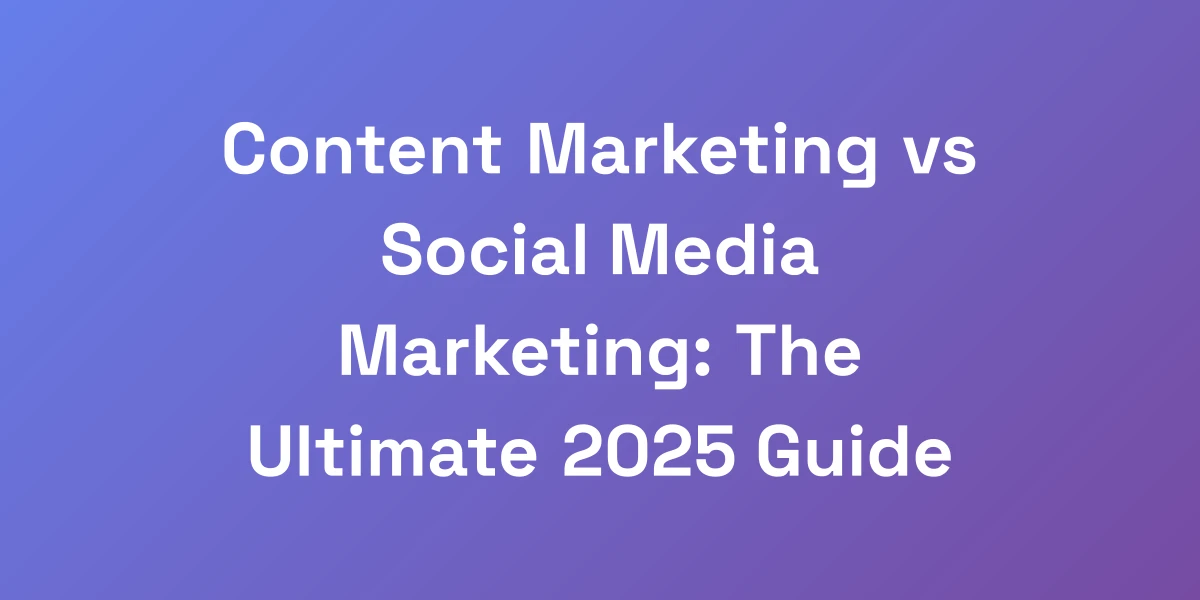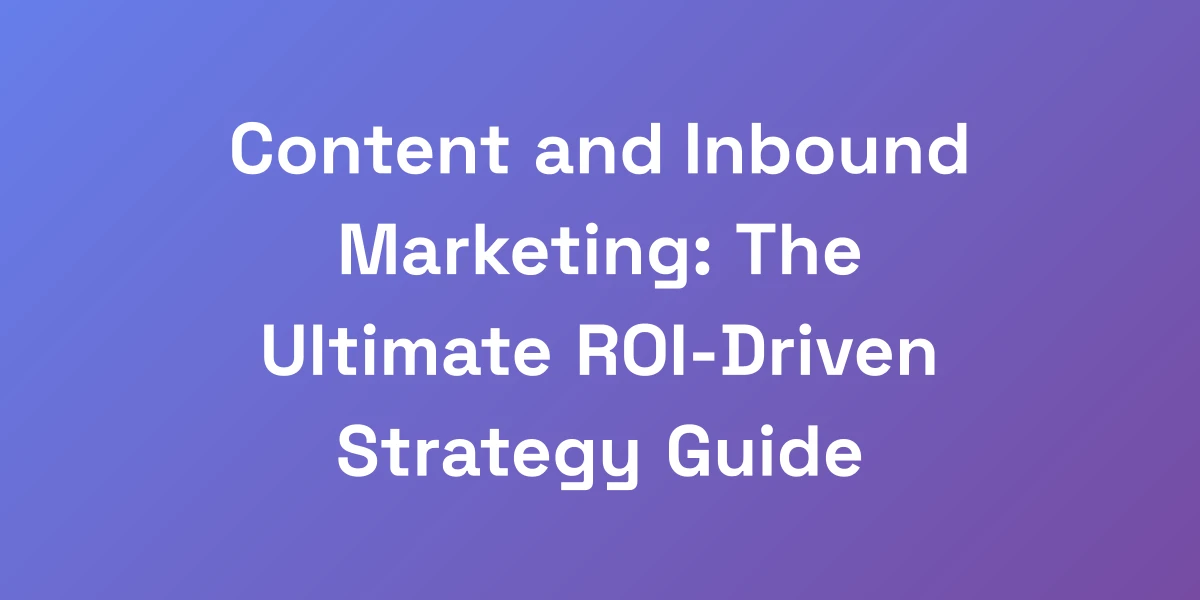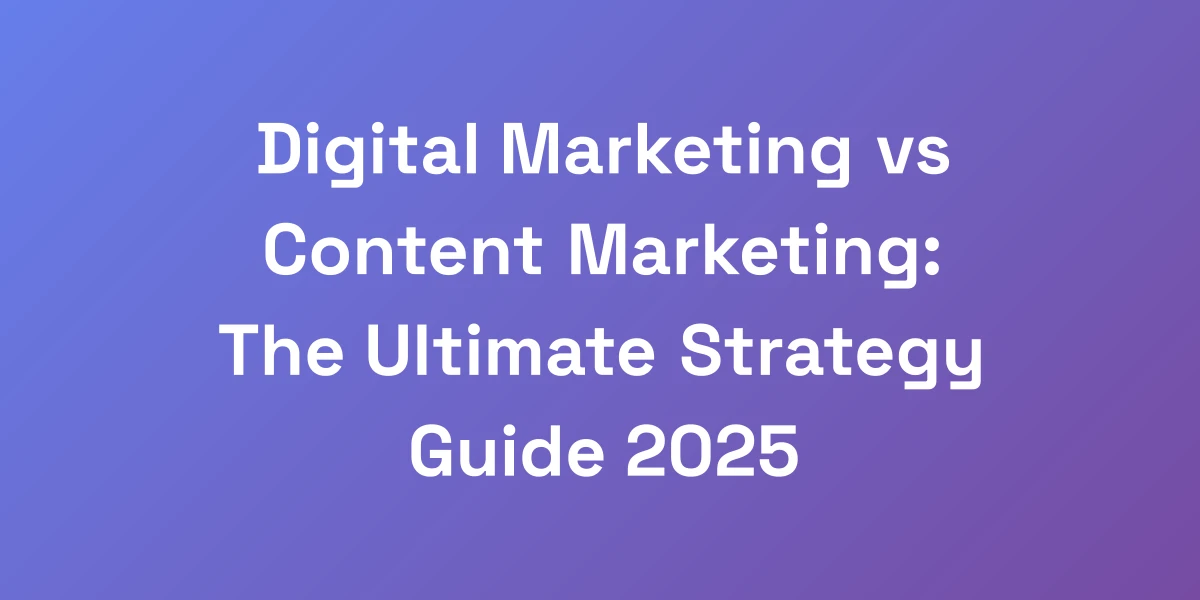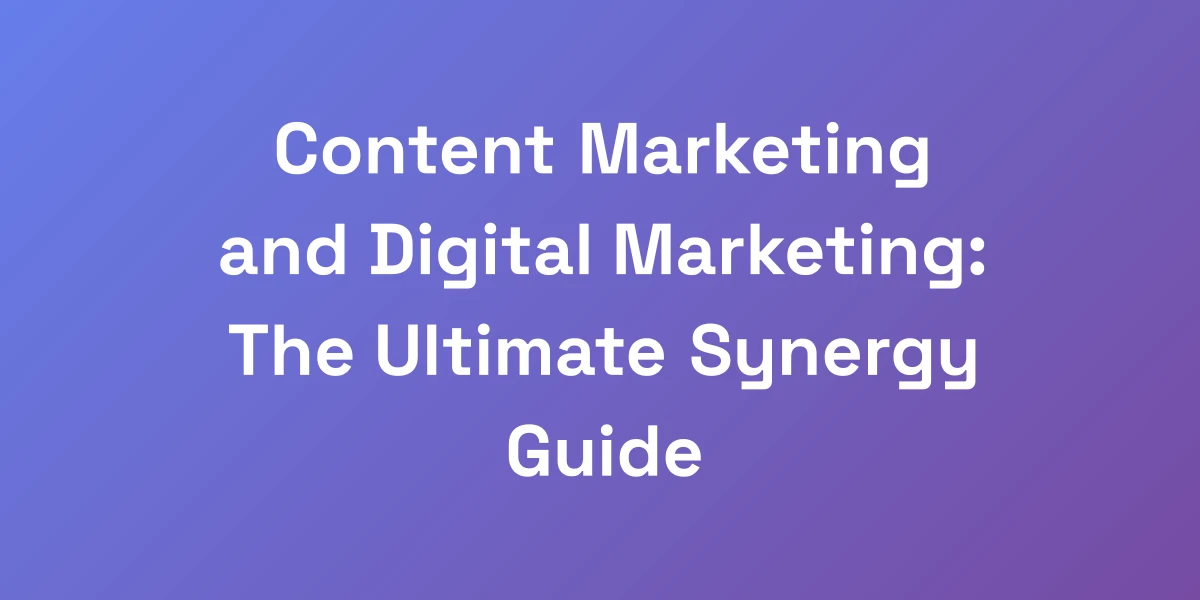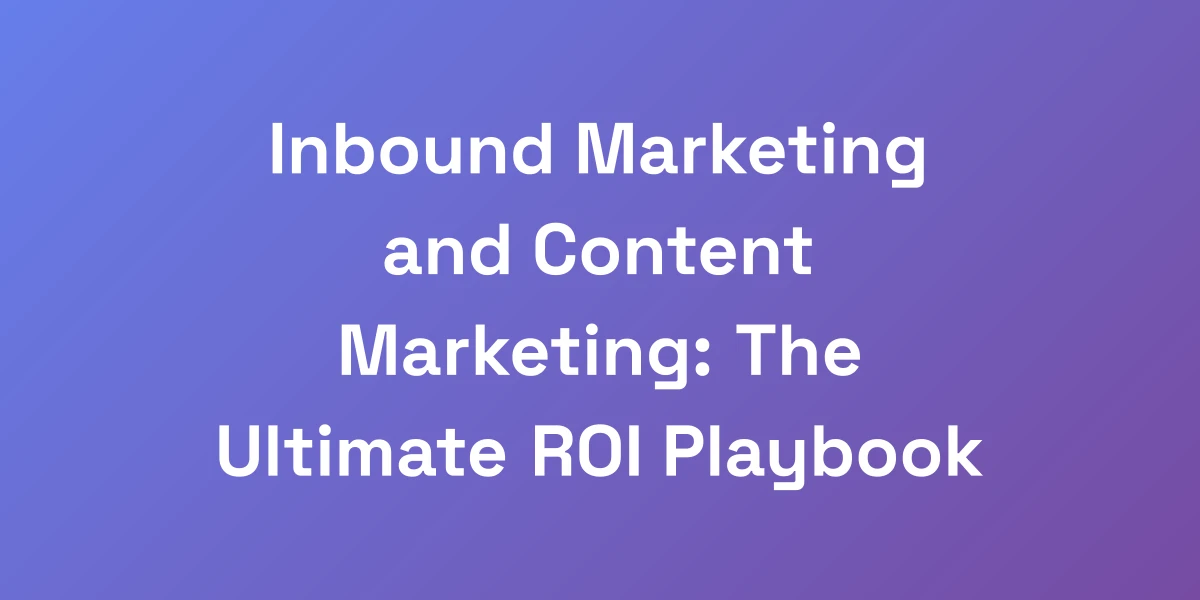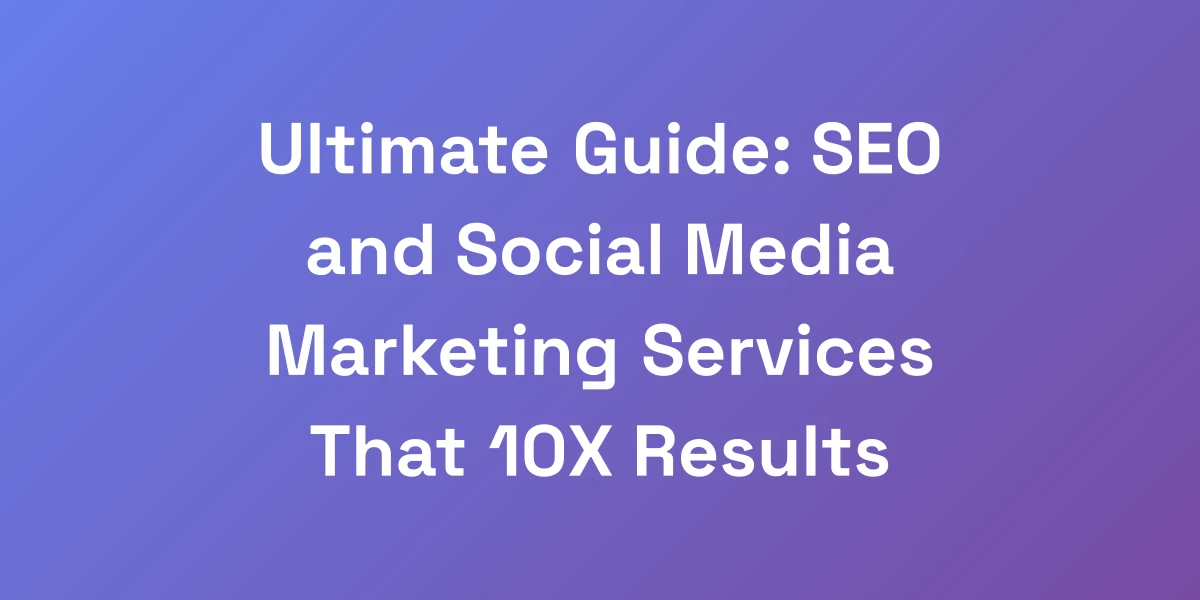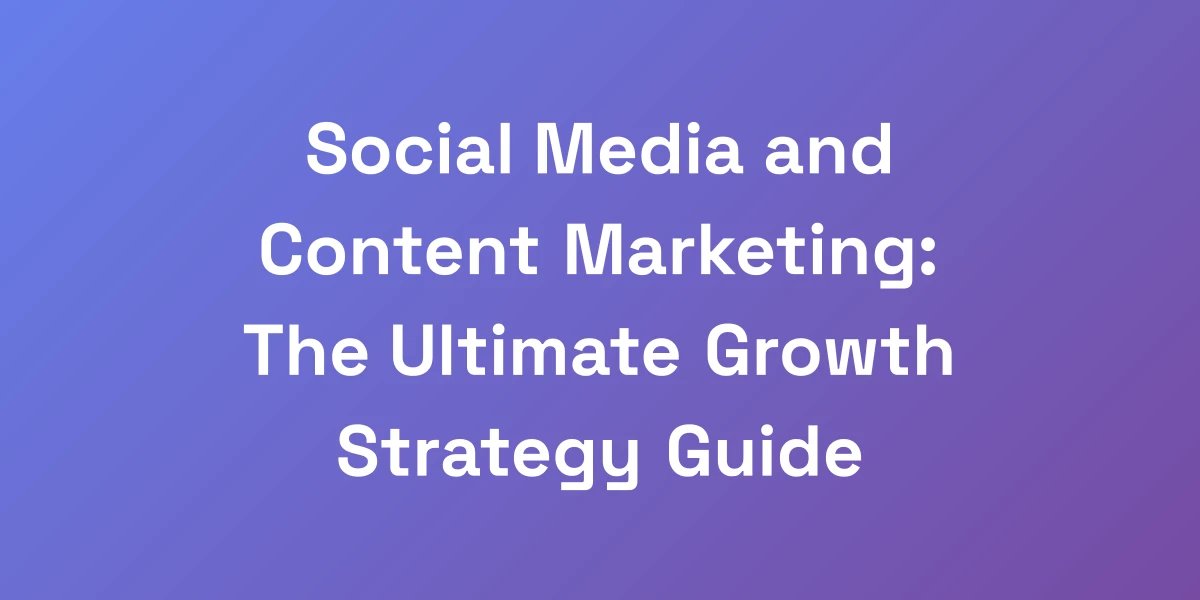
Social Media and Content Marketing: The Ultimate Growth Strategy Guide
Mar 15, 2025 | By [email protected]
Understanding the Synergy Between Social Media and Content Marketing
Let me hit you with some truth: most businesses are doing both social media content marketing wrong. They’re treating them like two separate beasts when they should be working together like a well-oiled machine.
Here’s the reality: when you combine these two strategies correctly, you’re not just adding their benefits – you’re multiplying them. We’ve seen businesses 10x their engagement and traffic by understanding one simple principle: content without distribution is worthless, and distribution without quality content is just noise.
Let’s break down how to make these powerhouses work together.
Defining Modern Content Marketing in 2025
Content marketing in 2025 isn’t just about blogging or creating videos. It’s a strategic blend of various formats tailored to different stages of the customer journey.
We’re talking about immersive experiences – think interactive infographics, personalized email sequences, and AI-driven chatbots that engage users in real-time.
The game has shifted towards creating value at every touchpoint. Modern content marketing integrates seamlessly with technology and user behavior, making it more targeted and effective than ever.
For example, consider how Dove revamped its “Real Beauty” campaign by using data-driven insights to create content that resonated deeply with their audience, boosting brand loyalty and engagement.
The Evolution of Social Media Marketing
Social media marketing has come a long way since the days of static posts and basic interactions.
Today, it’s a dynamic arena where real-time engagement, influencer collaborations, and platform-specific optimizations reign supreme.
Platforms like TikTok and Instagram Reels have revolutionized how brands interact with their audience, emphasizing short-form, high-impact content that captures attention quickly.
We’ve observed significant shifts, such as the decline in organic reach on platforms like Facebook and X (formerly Twitter), pushing businesses to adopt paid strategies and more innovative content approaches to stay visible.
Why Integration is No Longer Optional
Integration of social media and content marketing isn’t just a good idea – it’s essential. Separate strategies mean fragmented efforts and diluted results.
When we integrate these strategies, we ensure that our content is not only high quality but also strategically distributed to maximize its reach and impact.
Take the example of a brand that creates a comprehensive blog post and then slices it into bite-sized social media snippets, ensuring consistency across channels while catering to platform-specific audiences.
This seamless integration results in a unified brand message, stronger audience connections, and ultimately, better ROI.
The Multiplier Effect of Combined Strategies
When social media and content marketing work together, their combined effect far outweighs their individual impacts.
For instance, a well-crafted video can serve not only as engaging content on your website but also as a viral hit on platforms like YouTube and TikTok.
We’ve seen brands increase their reach and engagement exponentially by cross-promoting content, leveraging each platform’s strengths to amplify the message.
This multiplier effect means that your efforts on one platform can significantly boost your presence on another, creating a network of interconnected strategies that drive sustained growth.
Key Performance Metrics for Integrated Marketing
Tracking the performance of integrated marketing strategies requires a nuanced approach. It’s not just about likes and shares anymore.
We focus on metrics that truly reflect business goals, such as:
- Lead Generation: How effectively your content is turning viewers into potential customers.
- Conversion Rates: The percentage of leads that become paying customers.
- Engagement Rates: Beyond likes, this includes comments, shares, and overall interaction.
- Return on Investment (ROI): How much revenue your integrated efforts are generating relative to their cost.
Tools like Semrush highlight that 54% of marketers are seriously tracking their content marketing statistics, often integrating social media as a key distribution channel to measure these metrics effectively.
Creating Content That Dominates Both Platforms
Listen, I’m going to tell you something that might hurt: your content probably sucks. And it’s not because you’re not good at what you do – it’s because you’re creating content for the wrong reasons.
The game has changed. The winners in today’s digital landscape aren’t just creating content; they’re creating content that’s specifically engineered to perform across multiple channels.
We’ve tested thousands of pieces of content, and we’ve found that the ones that generate the most revenue follow a specific formula. Let us show you how to create content that works harder than you do.
The Content Multiplication Framework
Ever heard of the content multiplication framework? It’s about maximizing the value of each piece of content by repackaging and redistributing it across various platforms.
Here’s how it works:
- Create a Foundation Piece: Start with a comprehensive piece of content like an in-depth blog post or a whitepaper.
- Break It Down: Extract key points, quotes, and insights from the foundation piece.
- Repurpose: Turn these snippets into different formats – tweets, Instagram posts, LinkedIn articles, and short videos.
- Distribute Strategically: Share these repurposed pieces on the most relevant platforms, tailored to each audience’s preferences.
This approach ensures that your core message reaches a wider audience without the need to constantly create new content from scratch, saving time and resources while maintaining high engagement levels.
High-Converti ng Content Types
Not all content is created equal. To dominate both social media and your content marketing efforts, focus on high-converting content types.
These include:
- Short-Form Videos: Platforms like TikTok and Instagram Reels showcase short, engaging videos that capture attention quickly. According to HubSpot, short-form videos offer the highest ROI.
- Long-Form Blog Posts: In-depth articles that provide value and answer specific questions can drive organic traffic and establish authority.
- Infographics: Visually appealing and easy to digest, infographics can simplify complex information and enhance shareability.
- Interactive Content: Quizzes, polls, and interactive infographics engage users actively, increasing the likelihood of sharing and conversion.
By diversifying your content types, you cater to different audience preferences and maximize your chances of conversion across various platforms.
Platform-Specific Optimization Techniques
Each social media platform has its own set of best practices and user behaviors. To truly dominate, your content needs to be optimized specifically for each platform.
For example:
- Instagram: Focus on high-quality visuals and leverage Stories and Reels to increase engagement. Reels, in particular, showed a 6.92% engagement rate in 2024, making them a crucial component of your strategy.
- LinkedIn: Prioritize professional and insightful content. Long-form articles and industry-specific updates perform well.
- TikTok: Embrace creativity and trends. Short, catchy videos that align with current trends can go viral quickly.
- X (Twitter): Timely updates and conversational content work best. Engage in real-time conversations and use hashtags strategically.
Understanding and implementing platform-specific optimizations ensures that your content is not just present but performs optimally where it matters most.
Content Repurposing Strategies
Content repurposing is about getting more mileage out of your existing content. It’s a smart way to maintain a steady stream of high-quality content without constantly starting from scratch.
Here are some effective strategies:
- Turn Blog Posts into Videos: Transform detailed blog posts into engaging video summaries or tutorials.
- Create Infographics from Data: Visualize key statistics and insights from your reports or articles.
- Develop Podcasts from Articles: Convert written content into audio format for those who prefer listening.
- Use Quotes and Snippets: Extract powerful quotes and snippets for use in social media posts, making them more shareable.
By repurposing content, you ensure that your core messages reach diverse audiences across multiple channels, enhancing your overall marketing efficiency.
Measuring Content Performance
To understand whether your content is hitting the mark, you need robust measurement strategies.
Focus on the following:
- Engagement Metrics: Track likes, shares, comments, and overall interaction to gauge content popularity.
- Traffic Analytics: Use tools like Google Analytics to monitor how much traffic your content is driving to your site.
- Conversion Rates: Measure how effectively your content is turning visitors into leads or customers.
- Social Sharing: Assess how often your content is being shared across different platforms, indicating its value and relevance.
Regularly analyzing these metrics helps refine your content strategy, ensuring continuous improvement and alignment with your business goals.
AI Tools for Content Creation and Distribution
AI tools are revolutionizing how we create and distribute content. From generating ideas to automating content creation, AI-powered content creation tools can significantly enhance your marketing efforts.
Consider tools like:
- ChatGPT: For brainstorming ideas, drafting content, and even engaging with your audience in real-time.
- Buffer: Simplifies scheduling and tracking social media posts across multiple platforms.
- ContentStudio: Offers comprehensive features for content planning, creation, scheduling, and analytics, including auto SEO tools.
Using AI not only saves time but also improves the quality and performance of your content by leveraging data-driven insights and automation.
Building a Strategic Distribution Engine
Here’s what nobody tells you about distribution: it’s not about being everywhere – it’s about being in the right places at the right time with the right message.
I’ve seen companies waste millions on random posting when they should have been building a systematic distribution engine.
The truth is, if you’re not getting at least a 5x return on your content distribution efforts, you’re doing it wrong.
We’re going to show you how to build a distribution system that works while you sleep.
Creating Your Distribution Calendar
A distribution calendar is your roadmap for when and where to share your content.
Here’s how to create one:
- Plan Ahead: Schedule content distribution at least a month in advance to ensure consistency.
- Align with Marketing Goals: Ensure your calendar supports your overall marketing objectives, whether it’s brand awareness or lead generation.
- Include All Platforms: Map out content for every platform you’re targeting, tailoring the format and message accordingly.
By having a clear distribution calendar, you prevent last-minute scrambling and ensure that your content reaches your audience at optimal times.
Automated vs. Manual Distribution Methods
Balancing automated and manual distribution methods is key to maximizing efficiency and engagement.
Automated Methods:
- Scheduling posts in advance using tools like Buffer and ContentStudio.
- Automating email distribution based on user behavior.
- Leveraging AI to distribute content at peak engagement times.
Manual Methods:
- Engaging directly with your audience through comments and messages.
- Tailoring specific content based on real-time trends and feedback.
- Building relationships with influencers and partners personally.
Combining both methods ensures that you maintain a consistent presence while also personalizing interactions to foster deeper connections.
Cross-Platform Promotion Strategies
Cross-platform promotion is about leveraging each platform’s strengths to amplify your content.
Here’s how to do it right:
- Consistency is Key: Ensure your brand message remains consistent across all platforms, even if the content format varies.
- Tailor Content for Each Platform: Customize your content to fit the unique style and audience of each platform.
- Utilize Platform Features: Take advantage of specific features like Instagram Stories, LinkedIn Articles, and TikTok Challenges to enhance content reach.
For example, a detailed blog post can be summarized into a LinkedIn article, turned into a series of Instagram posts, and shared as a short video on TikTok.
Engagement Triggers and Timing
Timing and engagement triggers play a crucial role in how well your content performs.
We focus on:
- Optimal Posting Times: Use analytics to determine when your audience is most active and schedule posts accordingly.
- Interactive Elements: Incorporate polls, quizzes, and questions to encourage interaction.
- Real-Time Responses: Engage with your audience promptly to keep conversations going and build stronger relationships.
For instance, Dove’s “Real Beauty” campaign thrived by posting content when their audience was most receptive and by actively engaging with comments and shares.
Building Strategic Partnerships
Strategic partnerships can exponentially increase your content’s reach and credibility.
Here’s how to build them:
- Collaborate with Influencers: Partner with industry influencers who align with your brand values to amplify your message.
- Content Syndication: Share your content on reputable third-party sites like Outbrain and Taboola to reach new audiences.
- Joint Ventures: Team up with complementary businesses to co-create and promote content, benefiting from each other’s audience base.
These partnerships not only extend your reach but also add a layer of trust and authority to your content, making it more persuasive and impactful.
Analytics and Optimization
No distribution strategy is complete without a strong analytics and optimization framework.
Here’s what we focus on:
- Track Performance Metrics: Monitor key metrics such as engagement rates, click-through rates, and conversion rates to gauge content performance.
- Identify Trends: Use analytics tools to spot patterns and trends in content engagement, allowing you to pivot strategies as needed.
- Continuous Improvement: Regularly refine and optimize your distribution strategies based on data insights to enhance effectiveness.
For example, using tools like Semrush and affordable SEO services, businesses can track how their content performs across different platforms and make informed decisions to boost their marketing efforts.
Monetization Strategies That Actually Work
Stop creating content for likes and start creating content for revenue.
The biggest mistake we see is businesses focusing on vanity metrics instead of their bottom line.
We’ve helped companies turn their social media presence into multi-million dollar revenue streams, and it all starts with understanding one crucial concept: every piece of content should have a clear path to monetization.
Let us show you how to turn your followers into customers.
Direct Response vs. Brand Building
When thinking about monetization, it’s essential to balance direct response and brand-building content.
Direct Response content is designed to elicit an immediate action, such as making a purchase or signing up for a newsletter. This includes:
- Promotional offers and discounts
- Clear call-to-action buttons
- Limited-time offers
Brand Building content, on the other hand, focuses on long-term engagement and establishing trust. This includes:
- Storytelling about your brand’s mission and values
- Educational content that provides value without an immediate ask
- Customer testimonials and case studies
Both types are crucial. Direct response drives immediate revenue, while brand building lays the foundation for sustained growth and customer loyalty. Striking the right balance ensures that your content strategy supports both short-term gains and long-term success.
Creating Sales Funnels That Convert
A well-structured sales funnel guides your audience from awareness to purchase, and it’s integral to monetizing your content effectively.
Here’s how to create one:
- Top of the Funnel (Awareness): Use engaging content like blog posts, videos, and social media posts to attract a broad audience.
- Middle of the Funnel (Consideration): Provide valuable content such as eBooks, webinars, and case studies that educate your audience and address their pain points.
- Bottom of the Funnel (Decision): Offer compelling calls to action, product demos, and free trials to convert leads into customers.
By guiding your audience through each stage with targeted content, you increase the likelihood of conversion at every touchpoint, turning casual visitors into paying customers.
Leveraging User-Generated Content
User-Generated Content (UGC) is a powerful tool for monetization. It not only builds trust but also encourages community engagement.
Here’s how to leverage UGC effectively:
- Encourage Reviews and Testimonials: Positive reviews build credibility and influence purchasing decisions.
- Host Contests and Challenges: Engage your audience by encouraging them to create and share content related to your brand.
- Feature Customer Stories: Highlight real-life use cases and success stories to showcase the value of your products or services.
For example, Dove’s “Real Beauty” campaign thrived on UGC, with users sharing their own stories and experiences, thereby amplifying the campaign’s reach and impact.
Paid Promotion Strategies
While organic reach is valuable, paid promotion is essential for scaling your content’s visibility and driving significant revenue.
Here are some effective strategies:
- Sponsored Posts: Promote your best content to reach a larger and more targeted audience.
- Retargeting Ads: Re-engage users who have interacted with your content but haven’t converted yet.
- Influencer Partnerships: Collaborate with influencers to amplify your reach through paid campaigns.
Investing in paid promotions can significantly enhance your content’s visibility, driving more traffic and conversions than relying solely on organic methods.
ROI Tracking and Optimization
Tracking your ROI is critical to understanding which monetization strategies are working and which aren’t.
Focus on:
- Attribution Models: Determine which touchpoints are contributing most to conversions.
- Performance Metrics: Track metrics like cost per acquisition (CPA), lifetime value (LTV), and return on ad spend (ROAS).
- A/B Testing: Continuously test different strategies to identify what resonates best with your audience.
By regularly analyzing your ROI, you can make informed decisions to optimize your monetization strategies, ensuring that your efforts are both effective and efficient.
Scale and Automation Techniques
Scaling your monetization efforts requires efficient processes and smart use of automation.
Here’s how to scale effectively:
- Automate Repetitive Tasks: Use tools like Buffer and ContentStudio to automate scheduling, posting, and even some aspects of content creation.
- Expand Your Content Team: As your content strategy grows, consider expanding your team to include more specialists, such as content creators, strategists, and data analysts.
- Leverage Data and AI: Utilize AI-driven tools to analyze data, predict trends, and make data-backed decisions to scale your efforts intelligently.
By implementing these techniques, you can handle increased workloads without compromising quality, ensuring sustained growth and profitability.
Conclusion
We’ve taken a deep dive into how social media and content marketing can work together to drive significant growth for your business.
From understanding the synergy between these two strategies to creating high-converting content and building a robust distribution engine, it’s clear that integrating social media and content marketing is not just beneficial – it’s essential.
Remember, it’s not about being everywhere – it’s about being in the right places, at the right times, with the right message. By leveraging the strategies we’ve discussed, you can transform your content efforts into a powerful growth engine that not only engages your audience but also drives revenue.
Ready to take your social media and content marketing to the next level? Start implementing these strategies today and watch your business soar.
Have questions or need further insights? Reach out to us – we’re here to help you succeed. What’s your next move in integrating social media and content marketing?
